
Hans Christian Amberg (23 September 1837- 6 November 1919) was a Danish architect. [1]

Hans Christian Amberg (23 September 1837- 6 November 1919) was a Danish architect. [1]
After an apprenticeship as a carpenter, Amberg studied at the Royal Danish Academy's architecture school (1856–1865) while receiving instruction from Michael Gottlieb Bindesbøll, Christian Hansen and Ferdinand Meldahl. In 1874, he won the Academy's gold medal and spent the following two years travelling, mainly to Greece and Turkey.
Amberg exhibited at Charlottenborg Spring Exhibition (1863-1884), in Exposition Universelle (1878) in Paris, the Nordic Industrial, Agricultural and Art Exhibition (1888) in Copenhagen, and Copenhagen's City Hall exhibition (1901).
Amberg won a competition to design Christiansborg Palace in 1887. Amberg's design was used in the replacement building in Højbro Plads after St Nicholas Church was destroyed in the fire of 1795. [2]
Amberg's approach, like that of his contemporaries, was influenced by the Historicist requirement to adopt one or more historical styles in every assignment. He designed buildings in the Faroe Islands, including a residence in Thorshavn and Ejde Church (Ejde Kirke) on the island of Suðuroy (1880–1881); both with characteristic pyramid spires. His Tinghus in the centre of Esbjerg (1891) and the manor at Vindeholme near Nakskov (1913) are also notable.
His greatest achievements were, however, in the area of restoration and renovation work including that on the town hall of Ribe (1882–1884) and Ribe Cathedral (1882–1904) as well as the old priory at Mariager Abbey (1891–1892). [3] He also restored St Nicolas Church and, under the sponsorship of Carl Jacobsen, redesigned its spire (1908–1910); in collaboration with Carl Brummer, he designed a spire for the Church of Our Lady in Copenhagen. The latter project was, however, not completed prior to Jacobsen's death. [4]
Jacobsen was a Knight of the Dannebrog and held the Dannebrogordenens Hæderstegn.
He died in Copeghagen during 1919. He was buried at Holmens Kirkegård.
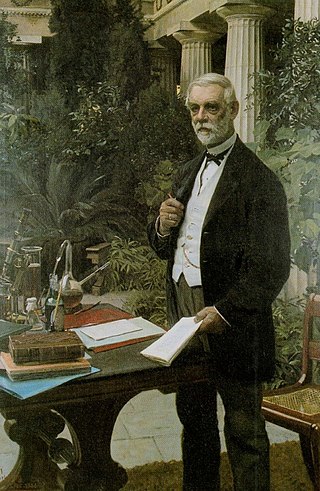
Jacob Christian Jacobsen, mostly known as J. C. Jacobsen, was a Danish industrialist and philanthropist best known for founding the brewery Carlsberg.

Carl Christian Hillman Jacobsen was a Danish brewer, art collector and philanthropist. Though often preoccupied with his cultural interests, Jacobsen was a shrewd and visionary businessman and initiated the transition of the brewery Carlsberg from a local Copenhagen brewery to the multinational conglomerate that it is today.

Caspar Frederik (Friedrich) Harsdorff, also known as C.F. Harsdorff, was a Danish neoclassical architect considered to have been the leading Danish architect in the late 18th century.

Niels Hansen Jacobsen was a Danish sculptor and ceramist. He is most famous for creating the once controversial sculpture, Trold, der vejrer kristenblod. The name of the statue is taken from a story in Norse folklore where the hero hides in the troll's castle. Thereafter, whenever the troll enters the castle, he cries: "I smell a Christian man's blood!"

The Church of Our Lady is the cathedral of Copenhagen. It is situated on the Frue Plads public square in central Copenhagen, next to the historic main building of the University of Copenhagen.
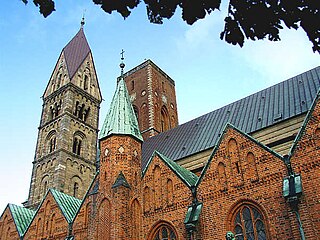
The Diocese of Ribe is a diocese within the Church of Denmark. Ribe Cathedral serves as the central cathedral within the diocese. Since 2014, the bishop has been Elof Westergaard.

Georg (George) David Anthon was a German born, Danish architect.
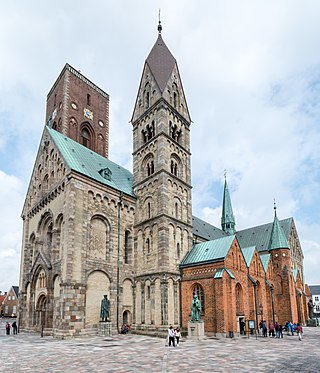
Ribe Cathedral or Our Lady Maria Cathedral is located in the ancient city of Ribe, on the west coast of southern Jutland, Denmark. It was founded in the Viking Era as the first Christian church in Denmark by Ansgar, a missionary monk from Hamburg, under permission of the pagan King Horik I. The cathedral has experienced several damaging events throughout its long history and has been restored, expanded and decorated repeatedly. As it stands today, Ribe Cathedral is the best preserved Romanesque building in Denmark, but reflects a plethora of different architectural styles and artistic traditions. It ranks among the most popular tourist attractions in Denmark and has been awarded two stars in the Michelin guide.

Martin Nyrop was a Danish architect.
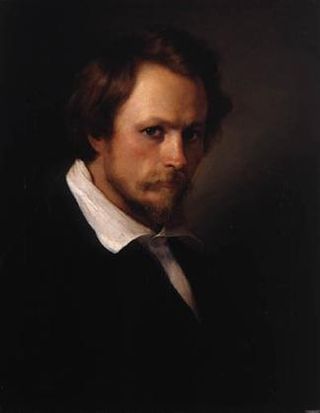
Emil Jens Baumann Adolf Jerichau was a Danish sculptor. He belonged to the generation immediately after Bertel Thorvaldsen, for whom he worked briefly in Rome, but gradually moved away from the static Neoclassicism he inherited from him and towards a more dynamic and realistic style. He was a professor at the Royal Danish Academy of Fine Arts and its director from 1857 to 1863.

The architecture of Denmark has its origins in the Viking period, richly revealed by archaeological finds. It became firmly established in the Middle Ages when first Romanesque, then Gothic churches and cathedrals sprang up throughout the country. It was during this period that, in a country with little access to stone, brick became the construction material of choice, not just for churches but also for fortifications and castles.

Esbjerg is a seaport town and seat of Esbjerg Municipality on the west coast of the Jutland peninsula in southwest Denmark. By road, it is 71 kilometres (44 mi) west of Kolding and 164 kilometres (102 mi) southwest of Aarhus. With an urban population of 71,698 it is the fifth-largest city in Denmark, and the largest in West Jutland.

Jens Vilhelm Dahlerup was a Danish architect who specialized in the Historicist style. One of the most productive and noted Danish architects of the 19th century, he is behind many of the most known buildings and landmarks of his time and has more than any other single architect contributed to the way Copenhagen appears today.

Ludvig Harald Knudsen was a Historicist Danish architect. He mainly designed churches.

Niels Sigfred Nebelong was a Danish architect who worked in the Historicist style. He was city architect in Copenhagen from 1863 and also designed many lighthouses around Denmark in his capacity as resident architect for the Danish lighthouse authority.

The Nikolaj Contemporary Art Center is an arts centre in Copenhagen which occupies the former St. Nicholas Church, named after Saint Nicholas, one of the city's oldest churches and most conspicuous landmarks. It is situated on Højbro Plads, a few steps away from Amagertorv and Strøget. The church building is noted for its fanciful Neo-Baroque 90 m (300 ft) long spire. The tower offers some of the best views of the city centre.
Vilhelm Klein was a Danish architect who adopted the Historicist approach, frequently emulating the so-called Rosenborg style and the Italian Renaissance style.

Nikolaj Plads is a public square located at the foot of the former St Nicolas' Church, just off Strøget, in the Old Town of Copenhagen, Denmark. Most of the buildings that line the square date from the rebuilding of the surrounding neighbourhood in the years after the Copenhagen Fire of 1795. The square is a quiet alternative to the much busier squares Amagertorv and Højbro Plads. The former church houses an exhibition space and a restaurant with outdoor service and a small playground is also located at the site.
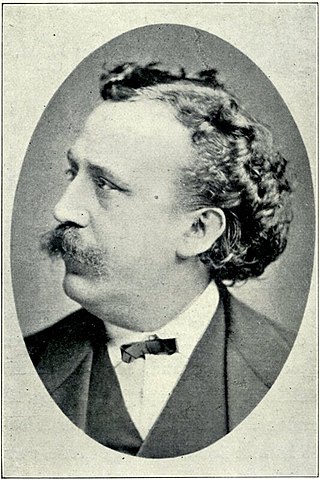
Bertel Christian Budtz Müller was a pioneering Danish photographer. He operated the photographic studio Budtz Müller & Co. at Bredgade 21 in Copenhagen and was appointed as court photographer in Denmark, Norway and Sweden.

Hans Christian Viggo-Hansen was a Danish painter, sculptor and artisan metalsmith.